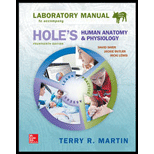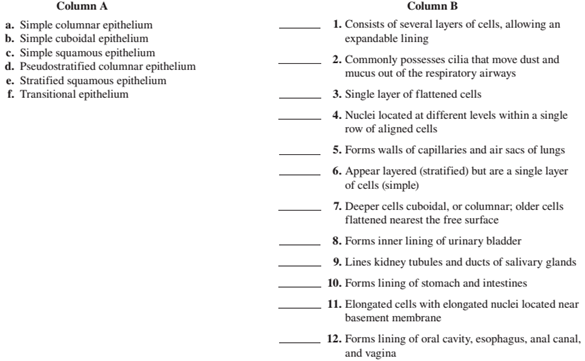
Concept explainers
Match the tissues in column A with the characteristics in column B. Place the letter of your choice in the space provided. (Some answers may be used more than once.)

To match:
The term from column A to the correct description in the column B.
INTRODUCTION:
In the complex body of the organisms which are multicellular in nature, different group of cells forms a tissue which performs various functions of the body like digestion, respiration, excretion etc. There are many cells and cellular layers which can be uni-layered or multi-layered,present in the body. Various tissues like epithelial tissue, connective tissue, muscular tissue and neural tissue are present in the multicellular organisms.
Answer to Problem 1.1A
The table below represents the correct match from the Column A to Column B.
| Column A | Column B | ||
| a. | Simple columnar epithelium | 7. 10. 11. | Deeper cells cuboidal, or columnar; older cells flattened nearest the free surface Forms lining of stomach and intestines Elongated cells with elongated nuclei located near basement membrane. |
| b. | Simple cuboidal epithelium | 9. | Lines kidney tubules and ducts of salivary glands |
| c. | Simple squamous epithelium | 3. 5. | Single layer of flattened cells Forms walls of capillaries and air sacs of lungs |
| d. | Pseudostratified columnar epithelium | 2. 4. 6. | Commonly possess cilia that move dust and mucus out of the respiratory airways Nuclei located at different levels within a single row of aligned cells Appeared layered (stratified) but are single layer of cells (simple) |
| e. | Stratified squamous epithelium | 12. | Forms lining or oral cavity, esophagus, anal canal, and vagina |
| f. | Transitional epithelium | 1. 8. | Consists of several layers of cells, allowing an expandable lining Forms inner lining of urinary bladder |
Explanation of Solution
- Simple columnar epithelium is a single layer lining. The term simple itself identifies it as a single layer and because it has slender, wider and comparatively longer cells hence the name columnar.It has microvilli on it in intestine and helps in more absorption and digestion of food particles also it is secretive in function because of which it helps in digesting food in the stomach by secreting digestive juices.
- Simple cuboidal epithelium as the name suggests has cells which are like cube in shape and it is also commonly found single layered only. It lines the glandular organs like kidney, liver, salivary glands etc. It helps in secreting various substances which helps in filtering blood in the kidney. Hence it also has secretory function.
- Simple squamous epitheliumhas flat, rounded and small cells with nucleus being placed centrally. They are not having a proper outline of the cell. They being thin cells helps in diffusion of various substances like air from respiratory tracts i.e. air sacs of lungs and also from blood vessels.
- Pseudostratified columnar epithelium is named so because the cells have nucleus at different levelswhich makes it appear as multi layers are present which is not actually true. The cells at free surface possess cilia which help in movement of mucous and prohibit foreign particles from entering the tract.
- Stratified squamous epitheliumis named so because strata mean layers, here the cells are actually arranged in layers so it’s a multilayered epithelium. The cells are lined upon as stacks. Its mainly responsible for the protection of our body from wear and tear. Therefore, it lines oral cavity, vagina, anal canal and so because at these places a lot of friction and trauma may occur which may result into injury of the underlying tissue.
- Transitional epitheliumis named so because this epithelium has cells which can undergo changes in their shape upon stress or distension. Therefore, it lines the urinary bladder. Upon urinary bladder being full, this epithelium can expand and when the bladder gets empty, the cells again can contract and regain their original shape.
Want to see more full solutions like this?
Chapter 8 Solutions
Laboratory Manual for Holes Human Anatomy & Physiology Fetal Pig Version
Additional Science Textbook Solutions
Evolutionary Analysis (5th Edition)
Microbiology Fundamentals: A Clinical Approach - Standalone book
Essentials of Human Anatomy & Physiology (11th Edition)
Study Guide for Campbell Biology
Microbiology: Principles and Explorations
Biological Science (6th Edition)
- What happens to the tissue if it is not immediately fixed?arrow_forwardwhat is the name of the TISSUE TYPE (entire bracketed area) at the end of the arrow for letter D? D1) What is the FUNCTION of the TISSUE TYPE?arrow_forwardPeter suffers from a knee injury involving damage to bone, cartilage and ligaments because of an accident during basketball practice. What can you tell him about the healing of these tissues? Explain your answer in 4 to 5 sentences. Indicate the reference/s of your answer.arrow_forward
- what is the full name of the layer at the end of the arrow for letter G? What is the name of this tissue type and what is its function?arrow_forwardWhat are the two types of tissue in this picture !?arrow_forwardMrs. Thompson was smoking a cigarette while using oxygen. The oxygen ignited causing 5th degree burns on Mrs. Thompson's forehead. To treat this area a. excising the tissue b. waxing c. excising the tissue, wax reconstruction, and cosmetics d. corrective cosmetic treatmentarrow_forward
- Surgical Tech For Surgical Tech Pos CareHealth & NutritionISBN:9781337648868Author:AssociationPublisher:Cengage
 Human Biology (MindTap Course List)BiologyISBN:9781305112100Author:Cecie Starr, Beverly McMillanPublisher:Cengage Learning
Human Biology (MindTap Course List)BiologyISBN:9781305112100Author:Cecie Starr, Beverly McMillanPublisher:Cengage Learning


